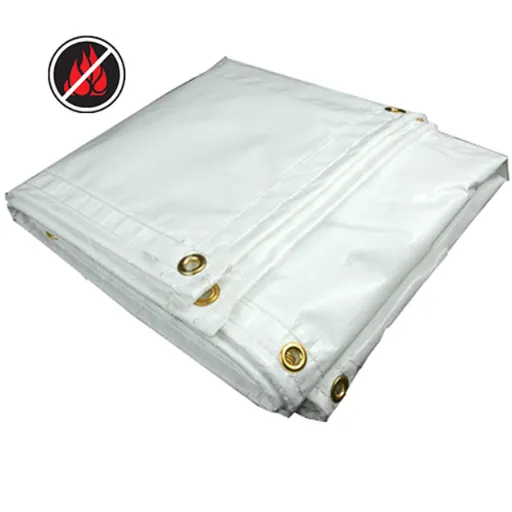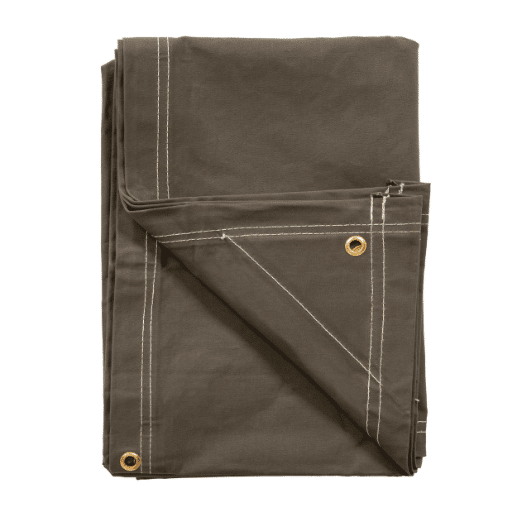If you’ve valued assets under a disadvantaged fire condition, then fire-retardant tarps are an assurance of value. Heavy-duty tarps incorporate in themselves the best-of-both-words: durability and innovative fire-resistance properties for ultimate protection. Design tarps for construction jobs, industrial works, or for covering your outdoor equipment, it is vital to know about fire-retardant tarps and their pros and cons. This article unveils the various features that give the tarps their charm, their many uses, and just why they are must-have implementations for safety-conscious professionals. Get ready to be introduced to durability and safety unlike any other.
Understanding Fire Retardant Tarps
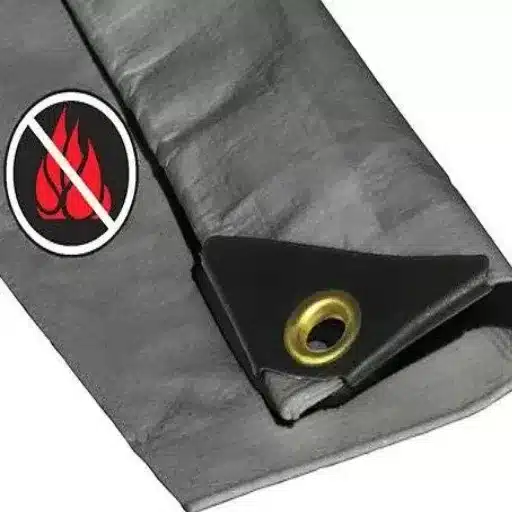
🔥 What is a Fire Retardant Tarp?
Fire retardant tarpaulin can be viewed as a covering that withstands the ignition of fire, retards flaming, or diminishes smoke production as the fire acts upon it. Mostly manufactured using flame resisting materials such as polyvinyl chloride (PVC) or silicone-treated fiberglass and subjected to stringent tests to meet certain fire standards such as NFPA 701 or CPAI-84, depending on the final use of the tarp. Unlike regular tarps, fire retardant tarps undergo chemical treatment or are constructed with fabrics that stand against fire by nature. This special construction safest those areas having a higher risk of fire, such as a construction site, under a welding bay, or on a stage for a public event. The performance of such tarps plays a crucial role in stopping a fire before it really gets going, in limiting structural damage, and thereby saving tragic loss of time to emergency services.
⚖️ Difference Between Fire Resistant and Fire Retardant
The terms fire-resistant and fire-retardant materials are often used as if they were the same thing, but they have different properties and applications. They are materials that resist heat, thus resisting fires, whereas some of them are endowed with flame-resistant or fire-resistant fibers. When the manufacturers generally want materials for long-term exposure in a highly aggressive environment, they choose these.
They differ as fire-retardant materials are not inherently fire-resistant, but through chemical treatment, the material is made to resist fire by slowing down the combustion process or by rendering itself less flammable under exposure to heat or flames. This treatment is done by coating, spraying, or mixing with additives. Wood, fabric, or plastics are therefore treated with various fire retardant chemicals, coatings, and sprays.
The very latest industry data supports efficacy for both types. Fire technology developments in recent times indicate fire-resistant materials to be better, particularly for situations of prolonged exposure in structural applications like fire doors or insulation panels. Whereas, fire-retardant materials are especially effective in situations where delaying flame spread is required-certainly in curtain fabrics, stage backdrops, or construction safety tarps. Knowing these subtle differences thus allows a correct choice, considering the particular safety norms, environmental risk factors, and application needs concerned.
🧱 Key Materials in Fire Retardant Tarps
Fire retardant tarps are designed using specialized-grade materials to enhance resistance to flame and heat in various applications. The most commonly used materials are:
Polyvinyl Chloride (PVC)
Some of the best fire retardant tarps made of PVC are coated fabrics which are durable and have outstanding fire-resistant properties. They have excellent resistance to ignition, very low heat conductivity, and hold up well under continued exposure to flame.
Polyethylene (PE)
Chemical fire retardants are often incorporated in Polyethylene tarps during manufacture. It is a very light, cheap material, and is treated under stringent safety standards like NFPA 701 or CPAI-84, making it handy for temporary outdoor and industrial use.
Silicone-Coated Fiberglass
It is used in welding or other heavy industrial applications, offering both prime flame resistance and unrivaled thermal stability. It is considered non-combustible with excellent durability, thereby providing high-performance service.
Canvas
Natural fiber tarps such as those made from canvas are treated with chemical coatings that are resistant to fire, in order to comply with fire safety regulations. Were it ever essential to ensure that aesthetic concerns and functionality had to coexist with safety in the theater or events, guarantee that such tarps are utilized.
Aluminized Fabrics
Aluminized fire-retardant tarps reflect heat and flames where radiant temperature becomes an extreme hazard. They are used in oil rigs, refineries, or emergency situations.
When choosing a fire resistant tarp, it is important to consider the referenced codes and certifications to check if the tarp meets the required performance in criterion. The materials are sometimes tested against UL 214 or BS 5867 standards; this testing helps ensure effectiveness and helps make a decision on what is appropriate under specific environmental or safety needs.
Specifications of Fire Retardant Tarps
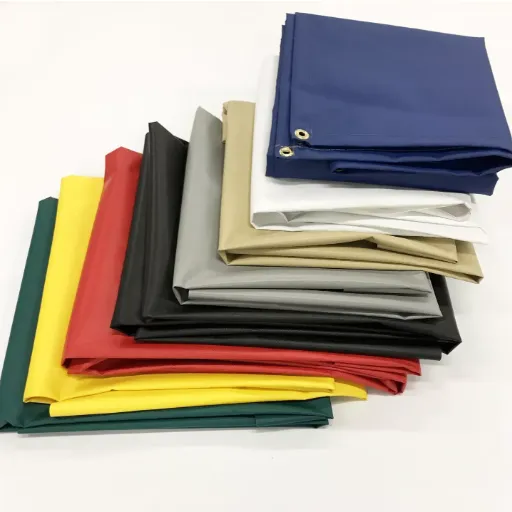
📏 Thickness Options: 8 Mil vs. 20 Mil
Hence, whether an 8-mil fire retardant tarp or 20-mil fire retardant tarp is chosen depends on the environmental needs, regulatory compliance requirements, and length of use. An 8-mil tarp surely goes the economical way in light applications of limited duration, while a 20-mil tarp assures much better heavy-duty performance over the long run.
🧵 Patterns of Weaves and Their Significance
The weave pattern in fire retardant tarps does affect the strength, durability, and the actual finishing. The two regular weaves used are plain weave and ripstop weave. By plain weaves, the structure is tightly interlaced to offer resistance against moderate wear and tear. Ripstop weave, however, affords a good resistance feature against wear and tear when the application demands higher durability since it toilets a grid reinforcement pattern to prevent tears from extending further.
Technical specifications of weave patterns vary greatly with different applications. For example, in areas expected to be subjected to high wind loads or physical abrasion, ripstop-weave tarps may have been specified to impart tear-resistance properties to the tarp. Recent search trends (including those from Insights) reveal questions from users inquiring about the longevity and ruggedness of tarps in adverse weather conditions. This very data points to choosing the right weave pattern depending on the nature of the stresses imposed by the environment. Selecting the appropriate weave pattern ensures compliance with safety standards and, hence, also pays economically by giving a longer service life to the tarp.
💪 Durability and Longevity of Fire Retardant Poly Tarps
Fire-retarded poly tarpaulins are made to withstand exposure to extreme environmental conditions. Hence, they may find use in industries equipped with higher safety standards. Based on the latest queries, commonly, users would like to know how these tarps maintain their integrity during prolonged lifespan in adverse climate. The reply to this is material composition, UV resistance, and reinforced construction.
They are usually polyethylene tarps made from either high-density polyethylene (HDPE) or low-density polyethylene (LDPE), treated to resist UV degradation and flame propagation- two important aspects in their durability. Further, due to the tightly woven mesh layer in tarps, they are not prone to tearing or stretching under wind pressure or abrasion on the surface. Modern manufacturing methods use two-layer coating technology which offers better waterproofing and protection against chemical exposure.
In order to maximize the life of fire-retardant tarpaulins, regular maintenance and cleaning, and proper tensioning during application are highly recommended. Users who require long-term deployment for their tarps must go for those with a good denier count and well-reinforced edging because a higher denier and edgings imply resistance against wear and tear. Finally, the choice of specifications according to installations guarantees efficient working and durability.
Applications of Fire Retardant Tarps
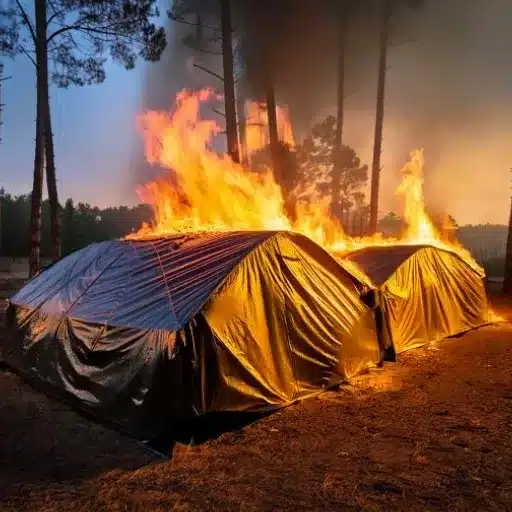
🏗️ Construction and Industrial Uses
These flame-retardant tarp systems play a central role in modern construction and industrial workflows, as they help minimize fire hazards while providing adequate protection from the elements. Based on the current data synthesized, there are several frequent industrial uses of fire-retardant tarps, including scaffolding enclosures, debris containment, and temporary weatherproofing. This flame-retardant functionality conforms to OSHA and NFPA safety standards, particularly in high-risk zones where heat or sparks may pose a hazard. They further remain instrumental on prolonged projects due to UV resistance and tensile strength, thereby allowing their use within various contexts governed under safety regulations and providing a valuable enhancement to the duration of operational viability.
🏕️ Outdoors and Recreational Purposes
Because of their durability and versatility, polyethylene tarps have become very essential in numerous applications in outdoor and recreational activities. They are usually used to build temporary shelters, protect an equipment, or lay on the-ground cover during camping or hiking trips. According to research supported by trend data, there is a rise in net searches for “heavy-duty tarps for camping” and that of “UV-resistant canopy tarps,” which means there is an increase in demand for weather-proof and robust materials. The tarps are essentially good for protection against UV rays, rains, or debris-the issues that most outdoor enthusiasts come across. Sure enough, the flame-resistant kind looks after safety when open flames are around, for instance, while grilling or having a campfire. At the same time, being lightweight and extremely high tensile, they are easy to carry and put up, hence fast becoming a worthy tool for individual outdoor adventurers, as well as for large outdoor event planners.
🚨 Emergency and Protective Covering Scenarios
An emergency and protective covering scenario illustrates the versatility and necessity of high-grade tarpaulins in various dire situations. According to recent Search trends, queries pertaining to emergency preparedness and weatherproofing have seen a sharp increase few months ago. Natural emergencies caused by hurricanes, tornadoes, or flooding are just some of the occasions when these tarps come into play. They quickly lend themselves to solutions including covering an exposed building to avert further water damage or covering up a breach in a roof or wall. Being waterproof and strong means they can safely be used on short notice to prevent another level of damage when an asset is affected, or when people start to become endangered. Flame-resistant versions of tarps have become helpful in different fires in the creation of temporary safe covers for endangered areas. Emergency shelters put to use by rescuers, erect tarps with improved features; the design laid down by contemporary tarp makers uses the best modern materials to meet the growing need for operational strength and resistance in sudden and hazardous conditions.
Safety Standards and Certifications
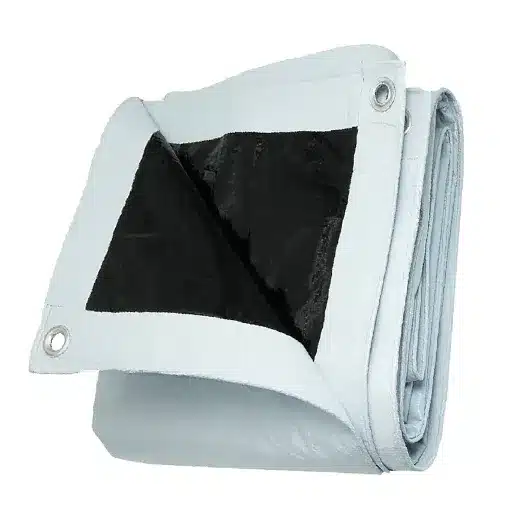
✅ A Dive into Certification Labels for Fire Protective Tarps
When evaluating fire retardant tarps, the certification labels that adorn them must be understood in order to ascertain their adherence to recognized safety standards. Two prime international standards most often insinuate NFPA 701, an insistence of the National Fire Protection Association, and CPAI-84, laying down specifications for flame resistance in portable tent materials. An NFPA 701 certification asserts that the tarp has been tested with a strict regard to its flame propagation characteristics wherein it resists ignition and limits the spread of fire. Contrariwise, CPAI-84 testing shall be required if an outdoor shelter is involved, establishing a material’s usefulness as a transient use with respect to fire hazards.
It could be certifications like ASTM International standards, say ASTM E84 for flame spread index and smoke development. A certification label means the tarps have been put through methodologies that are more advanced and aim at increased safety in dangerous situations. When purchasing a fire retarding tarp, make sure to look for these certifications, often including laboratory verification data demonstrating the product’s fire safety optimization with regard to the latest regulatory requirements. Always cross-check the validity of the certifications; the use of uncertified tarps or tarps that are falsely labeled in high-risk environments can lead to serious civil liabilities.
☀️ Importance of UV Resistance in Outdoor Tarps
A good outdoor tarpaulin must guarantee UV resistance, for exposure to such radiation leads to the erosion of tarp materials through time. UV light, an element of sunlight, affects many polymeric materials by acting on their molecular structures. It tends to fade, weaken, and make the material less flexible-a process not followed in those tarps that are resistant. Degradation causes one to question the efficacy of the tarp in applications demanding outdoor location and protection over long periods.
Depending on the factor observed and the exposure intensity, UV-resistant tarps extend by 20-50% in the service life of products compared to non-UV-resistant tarps. Special coatings and HDPE materials are typical features designed for UV protection. An outdoor tarp must carry a certificate ensuring it provides UV protection so that it can adequately protect equipment, materials, or spaces from weather-induced wear and tear.
🔬 Flame Retardancy Testing Methods
These tests are geared toward ensuring that the materials do, indeed, comply with safety standards by analyzing the materials’ resistance to ignition and flame spread. Usually, there are the Vertical Burn Test (UL 94), in which the material’s response to an open flame while held vertically is tested, and the Limiting Oxygen Index (LOI), which measures the minimum oxygen concentration needed to support combustion. The Cone Calorimeter Test (ISO 5660) is additional: It measures heat release rate, smoke release, and time to ignition, and so forth, giving a score to the behavior of the materials under fire.
Currently, increased emphasis has been laid upon Standard Test Method for Burning Characteristics of Building Materials (ASTM E84) Test. This test essentially asks the flame spread and smoke development indices, giving one insight into the safety of a material for interior uses. A combination of these tests can afford a complete view of fire resistance in materials, which industries such as construction, aerospace, and manufacturing must consider.
Buying Guide for Fire Retardant Tarps
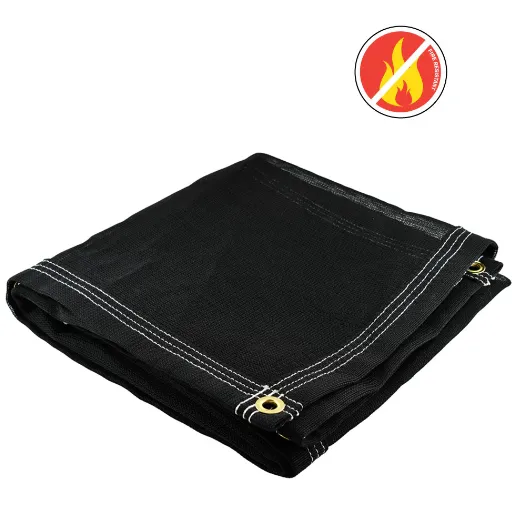
🛒 Heavy Duty Tarps: What Must They Have
While looking for heavy-duty tarps or fire-retardant tarps, some features must be considered along the lines of industry standards and application specifications. Below is a rundown of these important features:
- 📦 Material Composition
The tarps should be made out of high-quality polyvinyl chloride (PVC) or polyethylene (PE) materials that have been treated for fire retardance. Not only do these materials provide durability, but they also meet extremely stringent fire safety standards classified as NFPA 701 or CPAI-84. Always check certification as a means of identifying accepted standards. - 🔥 Flame Resistance Rating
Making sure that the tarps are tested to the relevant protocols that might include ASTM E84 and have a verifiable flame spread index and smoke development index is very important for applications wherein fire safety is of the essence. - ☀️ UV and Weather Protection
Heavy-duty tarpaulins should bear coatings for UV resistance to avoid sun damage with prolonged sun exposure. Also, ensure it is weatherproof and able to endure extremely adverse weather conditions. - 🔧 Reinforced Construction
Inquire about reinforced edges with grommets and rip-stop technology to provide more durability and resistance to tearing. This will be useful in outdoor or industrial scenarios, where several heavy strains could affect performance. - 🌡️ Temperature Tolerance
Look for those tarps which will work well in a wide range of temperatures. Often fire-retardant tarps must keep their integrity whilst enduring high heat and also freezing temperatures. - 📐 Size and Weight
Choose a size and weight suitable for your project. Though lightweight tarps may be easier to work with, heavy ones tend to give better durability and resistance.
Choosing heavy-duty tarps that maximize protection in every sense of the word-process involves considering certain specific features and their compliance with the relevant fire safety standards. Selection of a particular product must always determine its application for the product and its reviews from users or third-party testing for its performance reliability.
⚔️ Comparative Analysis: Poly Tarps vs. Canvas Tarps
According to recent data gathered, most consumer preference hangs on the final application. Poly tarps top search interests for lighter applications and cost-sensitive projects. On the other hand, searching for canvas tarps points toward a need for sturdier, industrial-grade performance. Following this data, choosing the right tarp requires strategic evaluation of environmental conditions, duration, and budget constraints suitable for specific operational needs.
🏪 Where to Purchase Fire Retardant Heavy Duty Tarps
From selecting a reliable seller of fire retardant heavy duty tarps for safety and compliance issues occupy the foremost position in my mind. According to search engine data, online stores such as Tarps Plus, MyTarp, and Heavy Duty Tarps are top choices under trusted retailers. These firms stock a huge inventory of fire-resistant tarps made out of premium materials, usually certified under NFPA 701 or CPAI-84 standards. Likewise, convenient purchasing options through big sellers on Amazon and Home Depot are available. This allows you to compare reviews and specifications. For large orders, some manufacturers can be asked to do custom work so direct purchase from them or from distributors could be the best option. In the end, the decision rests upon factors surrounding each particular project, i.e., size, type of material, certification levels, etc.
Maintenance and Care for Fire Retardant Tarps
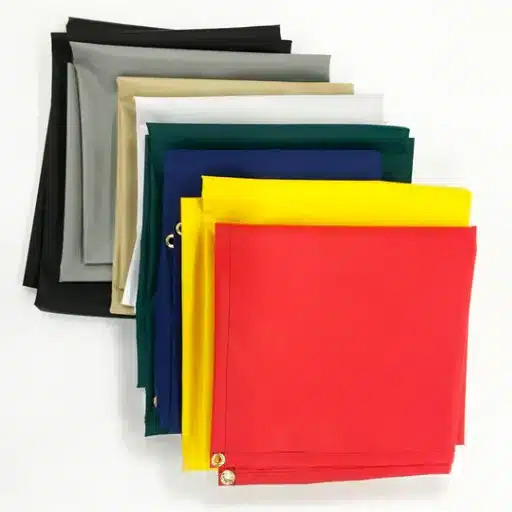
🧼 The Importance of Cleaning and Storage of Your Tarp
The conservation of fire retardant tarps is important for ensuring they last long enough to fulfill the purpose for which they were intended. While cleaning, use a soft-bristle brush or nonabrasive cloth to remove any loose debris or dirt on the surface. Avoid harsh chemical cleaners at all costs since they can damage the fire-retardant coating. Instead, use a mild soap solution combined with water. Scrubbing should be done gently, especially in areas of stains or build-ups. Rinsing should be thorough to wash away all soap residues, and the tarp should be dried completely in open air to prevent mold or mildew growth.
Whenever you store a tarp, folding or rolling it carefully so that there are no creases will prevent any damage or weakening of the material. Keep it in a cool, dry place, far from any sunlight or sharp objects that might poke through the fabric. Using a tarp storage bag or box for extra protection against dust, pests, and environmental exposure can be beneficial. At regular intervals, check for any damage during storage and refer to the manufacturer’s instructions regarding the repair or replacement time to maintain fire retardant efficacy.
🔧 Repairing Tears and Damage
In case of repairs on tears and rips to fire retardant tarps, complete methods of repairs should give more consideration to maintain structural integrity and its resistance to the weather. First, clean the area thoroughly, using mild soap and water, to remove dirt or oils with which the adhesive or patch may not stick well. After everything is clean and dry, start using the repair kit meant for fire-retardant tarps, the-consistency in the materials provided by the kit to the ones used in fire retardant treatment must be maintained. Orient the adhesive or patch so as to ensure full coverage and adherence to the tear; then allow them to cure under conditions recommended by the kit’s instructions.
While giving importance to guaranteeing that the repaired area should preserve the property of being fire retardant, this requirement has taken top priority on the user’s side, as per the latest data from search engine. Some repair kits are designed to retain fire resistance, but some do not meet the required specifications. For critical work, seek input from the tarp manufacturer concerning approved repair materials or consider using a professional repair service specializing in fire retardant fabrics. Performing regular inspections on the repaired area after work is completed will ensure that the repair remains secure and functional in actual operation, while curing materials or patches not complying with fire standards should never be used in the first place.
⏳ Extend the Life of Your Fire Retardant Tarp
Aforementioned maintenance procedures and storage procedure will increase the life span of your fire retardant tarp, in accordance with industry standards and expert recommendations. The tarp must frequently be washed with a non-abrasive solution shared with lukewarm water, so that dirt, oils, and other contaminants do not set over the fire retardant coating, chipping it away. Do not use strongly caustic materials or something that would disintegrate the tarp’s fire-protective attributes. The tarp should then always be stored in a cool, dry place to prevent it from being degraded through exposure to UV radiation and moisture, common agents of fabric deterioration, and mildew growth. New findings indicate that rolling rather than folding for storage helps to avoid stress at the creases and, hence, maintain good structural integrity.
In setting the tarp, be sure to have it properly fixed, so that points of tension do not develop or friction does not happen between abrasive surfaces that would cause damage. Further, consult with your manufacturer from time to time for steps on reapplying the fire retardant treatment, some of which may wear off as time passes with exposure to the elements. By combining best maintenance practices with updated information on product care, you should look at your fire retardant tarp as being reliable and durable for the duration of its intended service.
FAQ
Fire retardant tarps are used for?
The fire-retardant tarps act as a shield against flame and heat, and therefore they can be used on construction sites, for outdoor happenings, or for automotive purposes. These tarps are most useful in all kinds of environments where there exist great fire hazards, as they have been made to be slow-burning and self-extinguishing. They may also be forecasted downward, covering furniture or equipment outdoors. The use of fire retardant tarps also makes a way towards compliance with fire marshal regulations as required by many industries. Furthermore, while camping, they can be used to build a safe shelter.
How are fire retardant tarps made?
Basically, fire retardant tarps are strong tarps created from polyethylene or vinyl for flame resistance. In manufacturing, a fire-retardant coating is applied to the tarps so they qualify within safety standards such as NFPA-701 or California Title 19. The tarp’s corners and edges are usually reinforced and furnished with aluminum grommets for added strength and fastening. Thickness of the tarp can vary–8 mil is thinner and likely less costly, while 12 mil is thicker and suited for dirtier, more demanding applications. Of course, finished sizes can be built to order, thus affording the user several options for laying the tarp.
Are fire retardant tarps waterproof?
Some that this tarp does worst: rain and wind. Whatever, somebody still might want to go on with tarping! Water is, for some reason, the last thing we would want to treat against. Most of the tarps are water-resistant anyway. Many a fire retardant tarp gives great waterproofing-like protection of items from rain and moisture. Particularly where outdoor work is concerned, it may be extremely important. They usually protect the fabric with a laminate coating that will not let water through, while maintaining its flame resistance. Sometimes they will be UV-resistant glareshield to prevent sun damage and increase the life of the tarp. Whether it be covering vehicles, outdoor events, or storage, these tarps secure the items from damage in case of fire or water.
How could I care for my fire retardant tarp?
Upholding your fire retardant tarp means ensuring its longevity and capacity to work. Occasional cleaning, using mild soap and water, makes way for dirt and grit in reduction that might hamper its working capacity. Killer chemicals or abrasives are never to be applied to this tarp, since they would erode the fireproof coating. Before being stored, the tarp must remain completely dry to avoid mold and mildew formation. Periodic checks must be made on the tanlp for any rips or damage-occurring at the corners or grommets-in order to undertake repairs for the sake of maintainance of its protective features. Keeping up with the right maintenance will keep your fire retardant tarp in great shape for many years.
Can fire retardant tarps be used indoors?
Yes, these tarps can surely be used indoors, making them safe and suitable for a wide range of applications. They are perfect for construction or renovation activities, where temporary barriers have to be put up to protect against the threat of fires. Likewise, fire retardant tarps can cover or create safe zones for machinery in industrial settings. The fire-retardant nature of these tarps renders them conforming to safety regulations and thus suitable for indoor purposes. On the other hand, these tarps can also be used for paint jobs or repairs within the maintenance of a home, such as covering furniture there to guarantee safety against any fire hazards.
Reference Sources
Tarps Play Important Role in Protecting Workers, Hospital Construction Site
This article from Loma Linda University highlights the use of fire-retardant tarps in construction to protect workers and prevent environmental hazards.
Hot Work Policies & Procedures
Keene State College provides guidelines on using flame-resistant tarps to protect combustible materials during hot work activities.
Hot Work Permit
Salisbury University outlines the use of fire-retardant tarps or shields to ensure safety during hot work operations.

